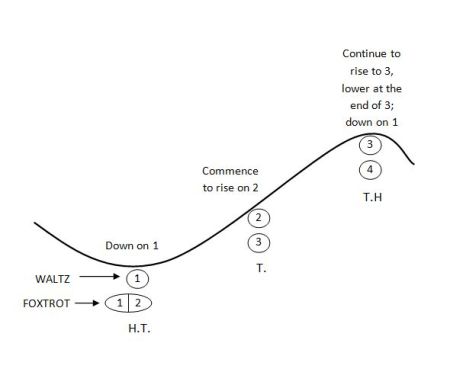We’ve all seen it - the elegant couple gliding across the floor, flowing up and down without a bump. It’s just one of those little details that separate the good dancers from the great ones. But here’s the thing: It’s not that difficult to start using it.
What is Rise and Fall?
As the name implies, rise and fall is the lifting and lowering of the body, giving the dance more grace and flow, both in look and feel. There are two kinds of rise, ankle or foot rise and body rise.
All smooth and standard dances (i.e. foxtrot, waltz, Viennese waltz, quickstep and tango) use rise and fall, with the exception of tango.
1. Keep Some Reserve
If you’re not doing it already, start dancing your smooth and standard with soft or gently flexed knees (yes, tango too). Soft knees act as shock absorbers to smooth out your movement and protect your joints in the long run.
 Warning! Careful not to straighten the knees at the peak of the rise, which can cause the dancer to overbalance and ‘tip over’. Keep the knees soft at ALL times.
Warning! Careful not to straighten the knees at the peak of the rise, which can cause the dancer to overbalance and ‘tip over’. Keep the knees soft at ALL times.
2. Heels, Balls, and Toes
Rising starts from the feet, so it’s important to know what yours are doing.
When walking forward normally, our weight rolls from our heels to the balls and toes of our feet as we push off. When we rise, the heel lifts off the floor and we step forward on our tip toes. When we fall, our heels lower down and we walk normally again. An exception is when we take a step directly backwards (followers, listen up); the only rise in this case is through the knees and body.
 The slower the dance, the greater the rise. Therefore a slow waltz has more lift in it then a quickstep.
The slower the dance, the greater the rise. Therefore a slow waltz has more lift in it then a quickstep.
3. Keep Your Timing
Rise and fall occurs at slightly different times from one dance to the next. The following table shows how it is used in different dance styles:

4. Foot Rise, THEN Body Rise
A natural-looking rise starts from the bottom-up. The ankles push down to lift the heels, followed by a straightening of the knees (keep them soft) and stretching of the spine. Imagine helium coming up from the floor and filling you up to the crown of your head. Likewise when you lower, it’s heavy energy filling you up, pulling your heels down to the floor, then bending your knees and compressing your body.
5. Rise as an Escalator, Fall as an Elevator
If you were to hold a paintbrush to the wall beside you as walked forward with rise and fall, the line would look a bit like an ocean wave:

Notice how the rise is much more gradual than the fall. Let the energy move gradually up as you travel through the step - careful not to shoot up all at once. We want this to be comfortable, right?
As the couple lowers, the leader begins to compress or ‘sink forward’ (or whichever direction he wants to go next), and starts to extend his leg in that direction. The follower receives his lead through the compression and extends her leg with him. So by the end of count 3, both couples have both lowered and extended most of the way, making count much easier to push into.
 Leaders make sure you begin to lower and compress before you send out your foot, to avoid colliding with your partner.
Leaders make sure you begin to lower and compress before you send out your foot, to avoid colliding with your partner.
Next section, we will look at some exercises you can use to start building a smooth and classy rise and fall from scratch.

Great practical advice, Ian, I appreciate it.